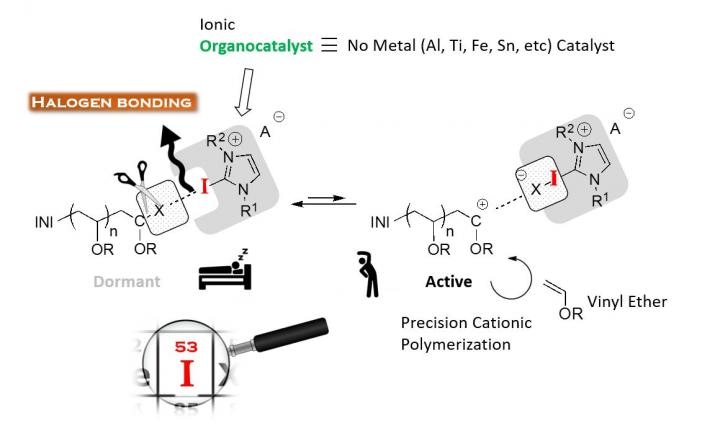Sep 21 2017
Chemists at the Nagoya Institute of Technology (NITech) have developed a metal-free method for collecting cationic polymerization capable of providing a new framework for superior quality industrial polymers applicable to bio-materials and semi-conductors.
The reaction relies on weak halogen bonding and the inclusion of a minimal amount of ammonium salt in order to develop homogeneous, long polymers. The study has been published in Chemistry - A European Journal.
 Through the reversible C-X bond scission by the ionic organocatalyst with the halogen bonding property, the metal-free and precision cationic polymerization of vinyl ether proceeded to give poly(vinyl ether) having the predictable molecular weight and narrow molecular weight distribution. Credit: NITech
Through the reversible C-X bond scission by the ionic organocatalyst with the halogen bonding property, the metal-free and precision cationic polymerization of vinyl ether proceeded to give poly(vinyl ether) having the predictable molecular weight and narrow molecular weight distribution. Credit: NITech
The polymer has been synthesized by cationic polymerization, as an example, via a reaction process that along with the vinyl molecule needs the incorporation of a catalyst and an initiator known as an initiating system.
Metal halide catalysts are well studied in cationic polymerization, but they create impurities responsible for the coloration and degradation of polymers. There is high demand for metal-free initiating systems.
Associate Professor Koji Takagi, First Author of the study
The challenge that lies in cationic polymerization is to develop a long polymer that is homogeneous without the addition of metal-based catalysts. The catalysts are responsible for abstracting an anion from the initiator, such as a halide, that reversibly works together with the catalyst and the polymer propagating end.
It is for this reason that weak bonding is preferred, otherwise side effects can take place that compromise the size and homogeneity of produced polymers. In the new study, Takagi and his colleagues demonstrate that chloride makes the best halide, as it produces suitably weak halogen bonds with a 2-iodoimidazolium catalyst.
"The 2-iodoimidazolium component is a requirement for the catalyst if we want to polymerize isobutyl vinyl ether (IBVE)," he said, speaking about the first vinyl compound scientists employed for demonstrating cationic polymerization.
The Researchers studied that if other halides were employed in the initiator structure, it would lead to degradation of some of the catalysts, partially because of the strength of the halogen bond.
The chloride anion used in his initiator is expected to efficiently shift back and forth between the catalyst and the propagating end of IBVE, thus producing a polymer with great molecular weight and narrow molecular weight distribution.
The study further demonstrates the suitable temperature (-10 oC) and concentrations of initiating a system for the reaction (10 mM each). These conditions help in reducing side effects that risked compromising the molecular weight distribution and molecular weight.
The addition of a small concentration of ammonium salt finally results in improving the controllability of cationic polymerization.
Adding ammonium salt allowed us to modify the polymerization rate and molecular weight distribution.
Associate Professor Koji Takagi, First Author of the study
Takagi finally remarks that the process has a huge number of attractive features for polymer synthesis, and expands the application of the polymer for bio-material and electrical usage.